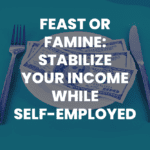The “broke college student” trope is so common because a lot of people have no clue how to make money in college.
In fact, many students graduate from college with more than just a degree—they also walk away with a mountain of debt and no real strategy to pay it off, let alone earning extra income and saving it.
But it doesn’t have to be this way. Even if you’re paying your own way through school, there are plenty of ways to make money in college. And with a bit of financial savvy, college students can set aside the money they’re making for bigger loan payments, renting or purchasing a home, or a rainy day fund.
Not sure where to start? You’ve come to the right place.
This article is your complete guide on how to make money in college (and save it, too!). Our best tips for college students are in this guide, but throughout, you’ll find links and resources that will likely be even more helpful for your particular situation.
Here are some of the best resources related to making money in college right up front:
How to make money as a college student: overview
If you’re like most college students, you’ll spend anywhere from 12 to 16 hours in class each week of the semester. And beyond that, you’ll spend at least another 5 to 10 hours each week studying and completing assignments.
Essentially, your schoolwork will take up as much time as a part-time job. On top of that, you’ll have social obligations and extracurricular activities that aren’t exactly going to leave you with a lot of extra time to make money while in college.
So what’s a student to do? Let’s examine a few of the easy ways to make money in college, along with long-term strategies that will take a bit more discipline.
Before you start: budgeting your time
Before you start learning how to make money in college, you need to pause and take stock of how much time (and what hours) you have to dedicate to a job.
As a student, this can be tricky to pin down because your schedule will change every semester. This is why so many college students figuring out how to make money at school take jobs that have flexibility built in. Food service, retail, and hospitality are often ideal jobs for students who don’t have much job experience and need something they can fit in between classes.
Keep in mind that you aren’t the only student looking for ways to make money in college. Showing up to job interviews with a clear outline of your availability will put you ahead of others.
On-campus or off-campus jobs?
Colleges and universities know students are looking for ways to earn money while studying. That’s why many offer on-campus job opportunities, such as part-time jobs in the bookstore, cafeteria, or within your major’s department.
Working an on-campus job definitely has its benefits. First, if you’re living on or near campus, then your work commute will be pretty short (or non-existent). This can make a huge difference when you’re low on time, as many college students are.
Second, a campus job will be well-prepared to accommodate your schedule. They likely already have other students who can fill in the gaps in your roster, so you won’t have to worry about being turned down because of your courses.
Finally, a campus job may offer you additional benefits, such as course credits or discounted services. These are factors you should absolutely consider as you mull over how to make money at school.
However, there are benefits to consider when it comes to off-campus jobs as well. You may be able to find better pay or benefits somewhere not affiliated with your school, and sometimes it can be nice to have time in your schedule that isn’t spent on campus.
Ultimately, the decision comes down to three important questions:
- Will you make more money off-campus or on-campus?
- Which jobs will best accommodate your schedule?
- Which jobs will be fulfilling and help you on your career path?
Where and how can college students find jobs?
You’ve figured out which hours you can dedicate to work. So now, how do you actually find jobs that will help you shed the “broke college student” persona?
First, if you aren’t looking for traditional college jobs, you can skip ahead to the next section.
But if you’re looking for a traditional college job, there are places you can go to find work and actions you can take to increase your odds of landing a college job you really want.
Finding on-campus jobs
If you’ve decided an on-campus job is something you’d like to pursue, your first course of action should be to find out whether your school hosts job fairs. Universities and colleges will often host these once or twice a year (typically at the start of semesters) to help fill new positions and find students looking for work.
If you’ve missed the on-campus fair or your school doesn’t have one, then reach out to the career center or student union. Odds are, they can point you in the right direction. You can also look into job boards on your school’s website or simply watch for working students and ask them for guidance.
Finding off-campus jobs
If you’re looking for something off campus, you have lots of options when it comes to finding a job. There are plenty of websites you likely already know about to find jobs—LinkedIn, Indeed, and Monster are all places that post frequent job listings, including jobs that are well-suited for college students.
And while the idea of going door-to-door with your resume in hand sounds outdated and like bad advice, there’s something to be said for doing on-the-ground job-hunting when living in a college or university town. Local businesses (like restaurants, cafes, hotels, etc.) rely on a steady stream of college students to keep them in business. Visiting these localities and inquiring about job opportunities could very well land you your off-campus job.
But simply knowing where to look is the first step. You still need to figure out how to stand out from other applicants and feel prepared for every part of the job application process. So here are some additional resources that can help you find jobs while in school:
How to make money in college without a job
Does the idea of working while in college full-time seem like too much? Maybe you only want a bit of supplemental income to fund your lifestyle while in college but don’t need something as formal as a traditional job.
You’re in luck—these days, college students have more choices than ever before when it comes to making money in college. Here are just a few of the ways you can go about getting some extra income:
Claim what’s already yours
Even if you’re the kind of person who knows exactly how much cash you have on hand, you may be surprised to find out that there are some hidden ways to make money out there.
Perhaps a loan company or insurance agency owes you a payout, or you were part of a class-action lawsuit you didn’t know about. There’s an easy way to find out.
Missing Money is a cool website where you type in your full name, and it spits out a list of any entities that owe you money you may have forgotten about.
Examples include utility deposits, money you forgot in a bank account, or an old check from a former employer.
Focus groups
If you’ve never heard of “focus groups,” they’re groups of people who’ve been vetted to share their opinions on a wide array of topics, such as brands, products, and ideas.
Focus groups can be conducted online or in person, and companies conduct them for market research purposes.
Usually, the group is led by a moderator, and it lasts for one to two hours. You can earn anywhere from $30 to $300 per session, but you must qualify to participate—i.e., they must choose you.
You can find focus groups in your area with a Google search or websites like FindFocusGroups.com.
Sell stuff you already own

The fastest, easiest way to make money in college is by selling things you already own. And if you’re like many Americans, you probably already have access to a bunch of things you don’t need that others would pay for.
Not to mention, selling your belongings has a few extra benefits beyond just a cash influx:
- You can declutter your living space
- Cut back on the waste you produce
- Give someone a chance to own something they need at a lower cost
The tricky part is deciding exactly what you can or should sell. Start by doing some inventory. Look at this list below, and make a list of things you own in each category.
Clothing & accessories: Think about items that don’t fit or match your style anymore. If you can’t remember the last time you wore it, do you really need it?
Technology: Still holding on to that last-generation smartphone? Haven’t picked up your Kindle in months? Tech can yield good prices, so consider selling what you don’t use.
Furniture and decor: There are always people looking to buy new furniture, and it’s so easy to sell it on places like Facebook Marketplace. If you don’t need it in your space, sell it to someone who does.
Books and supplies: Books and school supplies can take up a lot of space, and you don’t need to keep them around if you aren’t going to read them or use them again. But other students will appreciate taking your books and supplies at a discounted price.
Once you’ve identified the things you can sell, how do you actually get rid of them and get cash in exchange? There are a number of ways to go about this.

Host a garage sale
If you have a bunch of random stuff you want to get rid of, you can make some quick cash in an afternoon by hosting a yard sale. You’ll need to advertise your yard sale with posters in the area a week or two before, and it’s best to host it on a Saturday or Sunday as that’s when “yardsailors” are most active.
If you don’t have a place you can host a yard sale, consider teaming up with other people in your community or apartment block, or even setting up space at a local flea market.
Online marketplaces
You likely know the main online spaces for selling goods: Facebook Marketplace, eBay, Etsy, and Craigslist. It’s easy and free to set up accounts and list products on these pages, but you’ll have better luck if you do the following:
Research pricing: Look at items similar to what you’re selling in terms of quality and price accordingly.
Take clear photos: Clean/wash anything well before you take pictures, and get shots of your products from every angle in a well-lit space.
Be descriptive: Tell potential buyers all of the relevant details about the products—including size, dimensions, condition, and where/how to pick them up.
Be responsive: Get back to potential buyers quickly with clear communication.
Be safe: If you plan to meet up with potential buyers in person, always have someone else with you and meet in a public place. Make sure people know where you’re going and how long you plan to be gone. And if something feels off during a meetup, just walk away!
Consignment shops & pawn shops
There may be some businesses in your local area that will help you sell your old belongings. Many consignment stores will pay you cash or give store credit for your fashionable clothing in good condition. Flea markets and antique shops might buy old furniture or decor. Look online for shops in your area, and pay them a visit to see what they might pay.
Selling your hair

This may sound weird at first, but if you have long hair and need cash fast, selling your hair is a viable option. The best wigs and extensions are made of real hair, and they’re always in high demand, making it easy to sell fast.
Hair buyers want thick, healthy, untouched hair that’s at least 10 inches long. They aren’t interested in hair that’s been dyed, bleached, permed, etc., and they don’t want your hair if you’re a smoker or drinker.
List your hair on the following marketplaces:
Dog walking

If you love animals but don’t get to spend much time with them because you’re in college, a great way to kill two birds with one stone is to be a dog walker or pet sitter.
As a pet sitter, you can determine when you’re available to care for animals, making it perfect for a student with a consistent class schedule.
Many websites like Wag and Rover function as marketplaces for dog walkers, pairing you with people in your area who need pet care. But you may earn even better income as a pet sitter by marketing yourself.
Tell friends and family that you’re open and available to care for their pets (or plants) whenever they’re out of town. Ask them to keep you in mind and recommend you to others. Or you can make a few posters advertising your services and hang them up at local dog parks, pet stores, or hiking trails.
How to make money online

In our full guide on how to make money online, you’ll find a walkthrough of some of the best internet-based money-making opportunities to consider. But for now, let’s do a surface-level look at some different ways college students can generate income online while studying.
How to make money in college as a freelancer
Becoming a freelancer isn’t as easy as switching a light switch.
You’ll have to dedicate time to choosing your profession, finding clients, and producing the work. Depending on the freelance work you choose, you may also have to spend some money on equipment or software to get started.
You’ll also have to cultivate self-discipline as a freelancer. Unlike traditional jobs where employers give you a set schedule and automatically deduct taxes from your wages, you’ll need to manage your own time, income, and taxes.
But if you think you can handle those things, then starting your freelance journey now could help you avoid life as a “broke college student.” Not to mention, you can use your freelancing experience when you graduate and start applying for jobs, or you may decide freelancing is what you want to do as your long-term career!
Interested? The first step is choosing which freelance services you want to offer. And we have lots of resources that outline your options:
As you browse through these articles, think about which services you want to offer by considering three things:
- Skills: What you’re ok/good at/can learn quickly
- Passion: What you enjoy doing
- Demand: What’s in demand (What the market will pay you to do)
Your ideal freelance job will lie at the center of these three criteria.

Try your hand at influencing
It’s no secret that lots of people make money in college as influencers—they use their social following on platforms like Instagram or TikTok to land sponsorship deals or sell products.
Of course, not just anyone can be an influencer. The market for influencers is competitive, so the odds that you’ll rise to the top of the pile of influencers (while still studying full-time) are pretty low.
However, if you enjoy using social media, then attempting to monetize the time you already spend on these platforms isn’t a bad idea.

To succeed as an influencer, you’ll need to study the marketing techniques influencers use. Your first order of business should be growing a following, as you can’t start monetizing your channels until you have people to actually influence.
To improve your odds, drill down into a niche that will set you apart. Simply being a “food influencer” isn’t enough. But a specific niche—like focusing on cheap eats for college students—can help you carve a space for yourself and develop a loyal following faster.
Get paid to take online surveys

Companies want to know what you think and are willing to pay you for your feedback, hence the rise of websites like Swagbucks, which pay you to take online surveys.
Be forewarned: This is not a good way to make long-term income. The time you have to spend filling out surveys versus how much you can earn usually comes out well below minimum wage.
However, if you have some spare time and just need a small amount of cash soon, this might be an option to consider.
To get started, register for the sites below, complete your profile, and take a look at the opportunities that come your way. The sites will notify you when a survey matches your profile.
The best-paid survey sites:
Get paid to review websites and apps
With new apps and websites coming out every day, there are lots of developers and programmers out there looking for honest feedback.
And there are a number of websites that have popped up to gather that feedback from potential testers for small amounts of cash.
Once again, reviewing websites and apps isn’t going to earn you big bucks, and it’s definitely not a long-term solution for how to make money in college. But it is an easy way to get some cash on hand quickly.
Resources
-
- UserTesting: You’ll see how much each test is potentially worth before you start and get paid 7 days later.
- Intellizoom: Get paid $2-10, depending on whether it’s a standard survey or a study that requires you to record think-out-loud audio or video.
- Userpeek: Get paid $10 for every 15 – 20 minute video you record.
- Enroll: Get paid to test websites before they are launched.
- UTest: Like a job board for people seeking testers for their apps and websites.
- UserFeel: Get paid around $10 per test when tests are 20 minutes.
- Trymata: Get paid $10 per 15 to 20-minute test. Payments are made every weekday through PayPal.
- Testing Time: Get paid to conduct user testing studies, only if contacted when your profile is a match for marketing research.
How to save money in college
Hopefully, you’ve found at least a few ways you can make money in college. But an equally tricky feat is making sure that the money coming into your bank account doesn’t vanish just as quickly.
To get the full rundown on how to make your money last, check out our complete college saving guide. But for now, here are general tips that can help.
Educate yourself on personal finance

Unfortunately, many people go through their school years without getting much education around personal finance. This can result in people growing up feeling lost when it comes to managing their money.
If you aren’t a numbers person, learning personal finance may feel intimidating or boring. But improving your financial literacy is key to saving money in college and building the future you want.
There are more podcasts, books, and YouTube series dedicated to learning personal finance than we can recommend here. But you can start your journey by visiting some of these resources, which contain our best money-saving tips for college students:
Get your banking sorted now
Have you been using the same bank account since you were a teenager? Well, it may be time to switch now that you’re living on your own, especially if you’re bringing in new income.
Having your own bank account, and getting comfortable with checking in on it frequently (even when it might sting), is a huge part of saving money while you’re in college.
You want to choose a bank that’s convenient (nearby where you live, with good online banking), and you should shop around to find accounts that offer the best deals. Look into how much interest you can earn on a savings account and what other perks you might get, and then make the best decision based on those factors.
When that’s done, you can set up apps like Mint or YNAB to help you keep an eye on your finances, so you won’t be in the dark. Knowing exactly how much money you have at any given point will make it much easier to know when to set some aside for savings.
Build an emergency fund
If you’ve ever lived paycheck-to-paycheck, then you understand the pain of financial surprises. A major car repair, a health emergency, or an unplanned (but necessary) plane ticket can be pretty devastating to your bank account.
Enter the emergency fund.
Before saving money in college for anything else, save for this. We all have expenses, and for you broke students, there’s not always much to spare.
It’s worth scrimping on entertainment for a little while to start putting dollars toward a rainy day. Long-term, experts recommend that you have somewhere between 3-8 months of expenses saved up—but don’t let that overwhelm you in the beginning. Saving money in college is hard. Start with a smaller, more realistic goal—try $500 or $1,000 (even if you know it will take a long time).
Because when a surprise expense pops up (and believe me, it’s only a matter of time), you’ll be prepared instead of racking up debt.
College student budgeting

We’ve talked about making money in college and how to save it. When you combine these two things, you’re basically learning how to budget in college.
But budgeting for college students is a bit different than it is for other folks because there are lots of other questions to factor in:
What’s the cost of tuition at your university? Do you have any grants, scholarships, or financial aid?
Will you work over the summer, during school, or both?
Will you be getting meals provided on campus, or will you need to buy groceries?
Are you considering alternative education programs or community college to save on tuition?
Figuring out your total expenses (or comparing between options if you’re still deciding future plans) is the first step of budgeting 101 for college students.
Establish your credit history
Having good credit can make a big difference in life quality. With a higher credit score, you’ll have an easier time getting loans, applying for credit cards, or securing housing.
Meanwhile, a poor credit score can have detrimental effects and may prevent you from getting what you want in life.
It can take time to build up good credit, so starting when you’re still in college is a good idea. But how exactly do you do that?
First, start by checking your credit score. All Americans are entitled to a free credit report once a year. The FTC has more resources on that here.
If you want to improve your credit score, you’ll need to prove you are reliable and can pay off your bills on time. And to do this, you’ll need some bills! As you get older, bills will (unfortunately) be easy to come by. Paying your rent and utility bills on time will help you establish good credit.
But if you want to get an early start, consider opening a low-interest credit card. However, you should only do this if you’re sure you can pay it off every single month (before you get charged tons of interest fees).
If you think you may be tempted to use a credit card to cover expenses you can’t afford (like a night out at the bars or a fancy restaurant out of your budget), then stay away from credit cards for now. Credit card debt is no joke, and it can make it impossible for you to save money later on if it gets out of control. Fall behind on credit card payments, and you could end up tanking your credit score instead of improving it.
Of course, you can also improve your credit score by paying off your student loans on time. Unfortunately, student loans can also harm your overall financial health as a college student if you don’t know how to manage them, so let’s take a look at how to take care of your loans ASAP.
How to pay off student loans quickly

According to the Education Data Initiative, more than 45 million Americans have federal student loan debt, averaging over $37,000 per borrower.
Those kinds of numbers are big and impersonal, but you might feel differently if you use our student loan calculator to figure out how much you’ll be paying. If you’re like the median borrower, you can expect to pay at least $250 per month once your grace period ends.
Imagine what you would do if someone handed you $250 in cash right now. What would you use it for? A new pair of shoes? A nice dinner with friends? An investment in your savings account? Now, instead of getting those things, imagine throwing those things away. Burning the cash, trashing the shoes, or withdrawing from your bank account.
Now imagine doing that every month until you’re in your 40s.
If you’d rather be putting that money in your own pocket instead of giving it to loan companies that are charging you interest, then you should get serious about learning the ways to pay off student loan debt.
Make more than the minimum payment
The fastest way to pay off your student loans is by making bigger payments than your monthly minimum whenever you can. But if you’re a recent graduate still looking to land your first job after college, move up in your company, or grow your solopreneur career, that may seem impossible.
However, even if you can’t do it often, making any one-off payments toward your student loans will help. Think year-end bonuses, birthday money, tax refunds, or any other cash windfalls you have throughout the year.
It may not be as fun to use your extra cash to pay off loans, but you’re making a long-term investment. Paying off your loans now means you’ll pay less interest in the long run. You’ll be able to save more money faster and sooner.
Of course, you don’t need to put every single extra dollar toward your loans. But when you do have an unexpected income, use your college student budget to parcel out the extra dough, putting some toward loans, some toward savings, and some toward whatever the heck you want.
If you do this, over time you’ll need to put less money toward loans, meaning you can put more of it toward the fun stuff (without loans hanging over you like a storm cloud).
Refinance your loans
If you’ve got good credit and a steady income, you may be qualified to refinance your student loans.
Refinancing means you take out a new loan and use that money to pay off your old loan. Usually, this is so you can create a new term length and/or lower interest rate.
For example, you could refinance your 10-year student loan to a term of seven years. This would likely mean a higher monthly payment, but you’ll be three years closer to never having to make a loan payment again.
Whenever you’re considering financing, look for the best opportunities to lower your interest rate. This is key in helping you pay less in the long run.
So if you refinanced $50,000 worth of student loan debt from 8.5 percent interest to 4.5 percent, not only will you get out of debt almost two years sooner, but you’ll also save about $13,000 in interest. That’s a huge amount of money.
The best part? With a plan like this, your monthly payment would basically stay the same.
That’s a wrap
Money isn’t everything, but it IS a necessary part of life. So if you need a lil’ inspiration to take the initiative today? When you’re making money in college and beyond, never stop learning and setting new goals. Because the only one in charge of your financial future is you.
As a reminder, this piece you just read is our big write-up about how to make money in college. But there are lots of other related articles that go deeper into each section we covered. You can explore more and work those financial muscles even harder with these articles:



















